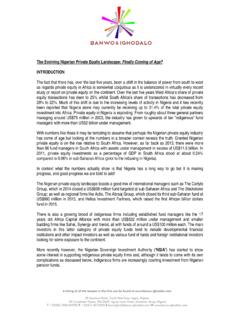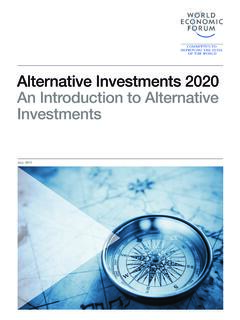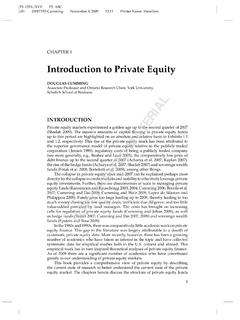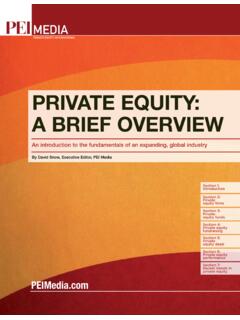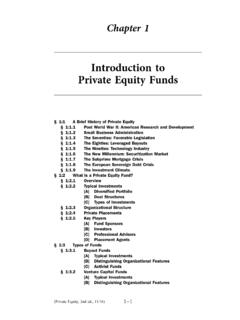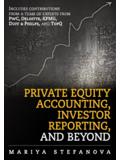Transcription of 1 An introduction to private equity - Assets
1 Cambridge University Press 978-0-521-19311-5 - A Practical Guide to private equity Transactions Geoff Yates and Mike Hinchliffe Excerpt More information 1. an introduction to private equity 1 introduction In this chapter we aim to provide a general introduction to private equity as it has been practised in the United Kingdom in the period up to January 2009. We will introduce some of the key players that shape the market and the types of deals that they do. This chapter will help to explain how private equity evolved into what it is today and will look at some of the factors that may influence its future. It is designed to set the scene for much of the rest of this book, and to give to the reader who is less familiar with the sector a welcome overview of a typical deal and some of the bigger issues in the private equity marketplace generally, but with a particular focus on the UK mid-market. Industry terminology exists in all markets and has its place as shorthand for those familiar with the territory.
2 Ever more colourful and elaborate phrases and acronyms are coined. In the private equity market they have (or once had). distinct and separate meanings and nuances. Many are now merging and being used inconsistently, creating an aura of spin and shimmer around the sector, and meaning different things to different people. We will seek to demystify some of the features of the market and the jargon used by practitioners and commentators alike. This chapter will set out some of the history of the industry and explain the key building blocks with which it has been built. One of these, as we will see, is the focus on the Business Plan. We will go on to consider the significance of the Business Plan in a private - equity -backed transaction, and the ways in which such Business Plan will be assessed by investors to underpin their desired financial returns. In particular, we will look at how management and their advisers put together the Plan, and what factors are of particular interest to private equity funders in the evaluation of the opportunity, including the types of businesses most likely to attract support.
3 We will also explain the importance of the financial return to private equity and some of the ways in which this can be measured. Much of this may sometimes seem very technical, especially for a reader who does not deal every day in the world of net present values, discount rates and internal rate of return (IRR). However, it matters knowing what good 1. in this web service Cambridge University Press Cambridge University Press 978-0-521-19311-5 - A Practical Guide to private equity Transactions Geoff Yates and Mike Hinchliffe Excerpt More information an introduction to private equity and bad looks like in the eyes of many private equity investors can be key to understanding how they value potential investments, how they behave on acquisitions and on exits, and how they react to underperformance. It can help you work with them, knowing what buttons to press (and what buttons to leave untouched), and predicting how they may react in any likely scenario.
4 It can also help in negotiations against them where this is in your own, or your cli- ent's, commercial interests. 2 Background to private equity in the UK. What is private equity ? The term private equity ' is a generic expression for investments in equity securities in companies which are not listed on any public stock exchange. Generally in the UK this means shares in limited companies, although there are exceptions (such as so-called vanity plcs', being public limited companies which are not listed on any investment exchange, but maintain plc status in order that the term plc' may be used in the corporate name).1. There is a wide range of types and styles of private equity , and the term therefore has different connotations depending on the circumstances (and pos- sibly jurisdiction) in which it is used. In the UK, as for most other developed economies, the expression is generally used to describe any type of transaction whereby a fund or group of funds invests monies either directly into an oper- ating company, or for the purposes of acquiring a company or group of com- panies (for ease of reference, referred to throughout this book as the Target').
5 Funds may be provided from a wide range of sources including pension funds, financial institutions and other institutional investors, companies, public bod- ies and high net worth individuals (for more on the different types of private equity funders in the UK market see section below). There are many different types of private equity transaction in the UK. Unfortunately, different expressions are sometimes used interchangeably and inconsistently, which can cause confusion. The following labels are most regu- larly encountered: (a) Management buyouts (MBOs, or buyouts). This phrase is generally used to describe the acquisition of a company (Target). by its incumbent senior management team, who up until the time of the buyout may have held either a limited equity stake, or no shareholding at all. MBOs may arise for a variety of reasons, the most usual being a corporate holding 1 There are implications to being a vanity plc rather than a private company.
6 For example, a pub- lic limited company must satisfy particular minimum share capital and other requirements set out in sections 4(2) and 761 767 of the Companies Act 2006, and a vanity plc will be subject to the requirements of the City Code on Takeovers and Mergers notwithstanding that it is not listed. 2. in this web service Cambridge University Press Cambridge University Press 978-0-521-19311-5 - A Practical Guide to private equity Transactions Geoff Yates and Mike Hinchliffe Excerpt More information Background to private equity in the UK. company disposing of a non-core subsidiary, or one or more private sellers looking to unlock the value in their company ( where there is no obvious successor to inherit a family business). Traditionally, such transactions were often sourced by the management teams themselves, who then took the Target business to the market for funding through retained advisers; however, as the private equity industry developed, it became more common for private equity firms to approach the Target, or for the seller(s) concerned to instigate the transaction, with management involvement being minimised until later in the process (see section below).
7 (b) Management buyins (MBIs). An MBI is identical to an MBO save that the management team that will invest alongside the private equity funds, and run the Target business, has not pre- viously been involved in the management of the Target. The lucrative profits earned by management teams from successful MBOs led to many individual managers researching their own industry sectors, with a view to identifying potential acquisition targets which they could then run with a deal funded by private equity . Individuals who have previously been successful in an MBO. often then move on to look for MBI opportunities. A pure' MBI ( where there is no involvement of any member of the management team within the existing business) is now rare in the UK. The lack of any inside knowledge of the Target business means that there is an increased risk to the funders of the transaction; even where a comprehensive due diligence exercise is carried out by external accounting, legal and other advisers, there is no substitute for experience from within the business.
8 As a result, many private equity funders refuse to contemplate MBIs at all. That said, on a buyout, the existing management team is often comple- mented by one or more managers from outside the business. In many modern deals in the UK, the team will include a combination of the existing man- agement team and managers from outside the company; such transactions are sometimes referred to as buyin management buyouts' (or, affectionately, BIMBOs) although such deals are often still simply referred to as MBOs or buyouts. (c) Leveraged buyouts and institutional buyouts (LBOs/IBOs). The expression leveraged buyout', or LBO, is used to describe a buyout where significant debt is utilised by the private equity firm in order to fund the acqui- sition of Target. The expression originates in America, although it has been used more extensively in the UK market in recent times (particularly as a con- sequence of the buyout boom between 2005 and 2007 see section ).
9 In reality, leverage is used to some degree by private equity firms in all buyouts to deliver the returns that their ultimate funders expect. In chapter 3, a typical deal structure is outlined demonstrating how bank debt (and, indeed, debt investment by the private equity investor) is combined with a relatively 3. in this web service Cambridge University Press Cambridge University Press 978-0-521-19311-5 - A Practical Guide to private equity Transactions Geoff Yates and Mike Hinchliffe Excerpt More information an introduction to private equity small (often, therefore, described as pinhead') equity investment. In the UK, therefore, whilst the expression LBO may generally be applied to any buyout, its use tends to be limited to those buyouts with particularly high levels of leverage often involving several layers of debt funding, as is described in more detail later in this Another expression often used is institutional buyout', or IBO.
10 This expression simply describes a transaction where the private equity investors are leading the acquisition process and will hold a substantial majority inter- est in the buyer vehicle (with the management team holding a relatively small, minority interest). In these cases, the relevant private equity firm or firms are often referred to as sponsors'. The terms LBO and IBO often go hand in hand because, as a general rule, as the deal size increases, it is far more likely that significant leverage will be required and that the transaction will be structured as an IBO with majority control in the hands of the private equity investors. (d) Venture capital In the UK, the terms venture capital' and private equity ' have often been used interchangeably, causing some confusion. Indeed, the principal trade body for private equity in the UK, the British Venture Capital and private equity Association, was simply the British Venture Capital Association until as recently as December 2008, and is still known in its abbreviated form as the BVCA.











